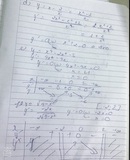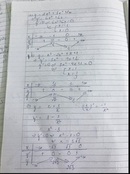
Hãy nhập câu hỏi của bạn vào đây, nếu là tài khoản VIP, bạn sẽ được ưu tiên trả lời.


\(f\left(x\right)=sin^4x+cos^4x=sin^4x+2sin^2xcos^2x+cos^4x-2sin^2xcos^2x\)
\(=\left(sin^2x+cos^2x\right)^2-\frac{1}{2}sin^22x=1-\frac{1}{2}sin^22x\)
Ta có: \(0\le sin^22x\le1\)
suy ra \(\frac{1}{2}\le f\left(x\right)\le1\).

\(f\left(x\right)=\frac{1}{3}x^3+2x^2+3x-1\)
\(f'\left(x\right)=x^2+4x+3\)
\(f'\left(x\right)=0\Leftrightarrow x^2+4x+3=0\Leftrightarrow\orbr{\begin{cases}x=-1\\x=-3\end{cases}}\)
Dựa vào hai nghiệm của đạo hàm bạn vẽ bảng biến thiên, thu được kết quả là:
\(y_{CĐ}=y\left(-3\right)=-1,y_{CT}=y\left(-1\right)=-\frac{7}{3}\)


TL
tham khảo nha bn chứ tui ko bít làm :}}
(y’ = 4x – 3;y’ = 0 Leftrightarrow x = {3 over 4};yleft( {{3 over 4}} ight) = – {1 over 8})
Đỉnh (Ileft( {{3 over 4}; – {1 over 8}} ight))
Công thức chuyển trục tọa độ tịnh tiến theo
(overrightarrow {OI} :left{ matrix{
x = X + {3 over 4} hfill cr
y = Y – {1 over 8} hfill cr} ight.)
Phương trình của ((P)) đối với hệ tọa độ (IXY) là
(Y – {1 over 8} = 2{left( {X + {3 over 4}} ight)^2} – 3left( {X + {3 over 4}} ight) + 1 Leftrightarrow Y = 2{X^2})
k cho tui nick naruto nha thank

\(y=\left(3x^2-1\right)^{-\sqrt{2}}\)
\(y'=-\sqrt{2}\left(3x^2-1\right)'.\left(3x^2-1\right)^{-\sqrt{2}-1}=-\sqrt{2}6x.\left(3x^2-1\right)^{-\sqrt{2}-1}\)


1: \(y=x+\dfrac{4}{\left(x-2\right)^2}\)
\(\Leftrightarrow y'=1+\left(\dfrac{4}{\left(x-2\right)^2}\right)'\)
=>\(y'=1+\dfrac{4'\left(x-2\right)^2-4\left[\left(x-2\right)^2\right]'}{\left(x-2\right)^4}\)
=>\(y'=1+\dfrac{-4\cdot2\cdot\left(x-2\right)'\left(x-2\right)}{\left(x-2\right)^4}\)
=>\(y'=1-\dfrac{8}{\left(x-2\right)^3}\)
Đặt y'=0
=>\(\dfrac{8}{\left(x-2\right)^3}=1\)
=>\(\left(x-2\right)^3=8\)
=>x-2=2
=>x=4
Đặt \(f\left(x\right)=x+\dfrac{4}{\left(x-2\right)^2}\)
\(f\left(4\right)=4+\dfrac{4}{\left(4-2\right)^2}=4+1=5\)
\(f\left(0\right)=0+\dfrac{4}{\left(0-2\right)^2}=0+\dfrac{4}{4}=1\)
\(f\left(5\right)=5+\dfrac{4}{\left(5-2\right)^2}=5+\dfrac{4}{9}=\dfrac{49}{9}\)
Vì f(0)<f(4)<f(5)
nên \(f\left(x\right)_{max\left[0;5\right]\backslash\left\{2\right\}}=f\left(5\right)=\dfrac{49}{9}\) và \(f\left(x\right)_{min\left[0;5\right]\backslash\left\{2\right\}}=1\)
2: \(y=cos^22x-sinx\cdot cosx+4\)
\(=1-sin^22x-\dfrac{1}{2}\cdot sin2x+4\)
\(=-sin^22x-\dfrac{1}{2}\cdot sin2x+5\)
\(=-\left(sin^22x+\dfrac{1}{2}\cdot sin2x-5\right)\)
\(=-\left(sin^22x+2\cdot sin2x\cdot\dfrac{1}{4}+\dfrac{1}{16}-\dfrac{81}{16}\right)\)
\(=-\left(sin2x+\dfrac{1}{4}\right)^2+\dfrac{81}{16}\)
\(-1< =sin2x< =1\)
=>\(-\dfrac{3}{4}< =sin2x+\dfrac{1}{4}< =\dfrac{5}{4}\)
=>\(0< =\left(sin2x+\dfrac{1}{4}\right)^2< =\dfrac{25}{16}\)
=>\(0>=-\left(sin2x+\dfrac{1}{4}\right)^2>=-\dfrac{25}{16}\)
=>\(\dfrac{81}{16}>=-sin\left(2x+\dfrac{1}{4}\right)^2+\dfrac{81}{16}>=-\dfrac{25}{16}+\dfrac{81}{16}=\dfrac{7}{2}\)
=>\(\dfrac{81}{16}>=y>=\dfrac{7}{2}\)
\(y_{min}=\dfrac{7}{2}\) khi \(sin2x+\dfrac{1}{4}=\dfrac{5}{4}\)
=>\(sin2x=1\)
=>\(2x=\dfrac{\Omega}{2}+k2\Omega\)
=>\(x=\dfrac{\Omega}{4}+k\Omega\)
\(y_{max}=\dfrac{81}{16}\) khi sin 2x=-1
=>\(2x=-\dfrac{\Omega}{2}+k2\Omega\)
=>\(x=-\dfrac{\Omega}{4}+k\Omega\)